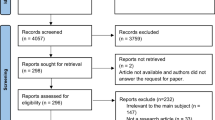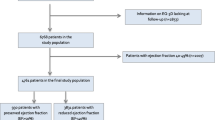Abstract
We examined the relationship between pain severity and outcomes in patients with heart failure with reduced ejection fraction (HFrEF) in the HF-ACTION randomized controlled trial. Trends of health-related quality of life (HRQoL) measures grouped by patients’ self-reported baseline bodily pain severity were compared using correlation tests, and the association between pain severity and clinical outcomes (including a primary composite endpoint of all-cause mortality and all-cause hospitalization) was assessed using multivariable adjusted analyses. Of the 2310 patients, 22.9% reported no pain, 45.8% very mild/mild, 24.9% moderate, and 6.4% severe/very severe. Greater pain severity was associated with worse HRQoL measures (EuroQoL-5D-3L and Kansas City Cardiomyopathy Questionnaire; both p < 0.0001). Compared to those reporting no pain, patients reporting severe/very severe pain had greater risk for the primary endpoint (adjusted hazard ratio 1.42, 95% confidence interval 1.11–1.83, p = 0.01). In patients with HFrEF, greater pain severity was associated with worse HRQoL and clinical outcomes. Trial Registration: NCT00047437
Graphical abstract



Similar content being viewed by others
Abbreviations
- BDI-II:
-
Beck Depression Inventory-II
- CCS:
-
Canadian Cardiovascular Society
- CPX:
-
Cardiopulmonary exercise
- CV:
-
Cardiovascular
- HF:
-
Heart failure
- HF-ACTION:
-
Heart Failure: A Controlled Trial Investigating Outcomes of Exercise Training
- HRQoL:
-
Health-related quality of life
- KCCQ:
-
Kansas City Cardiomyopathy Questionnaire
- NYHA:
-
New York Heart Association
- RER:
-
Respiratory exchange ratio
References
Bekelman, D. B., Rumsfeld, J. S., Havranek, E. P., et al. (2009). Symptom burden, depression, and spiritual well-being: a comparison of heart failure and advanced cancer patients. Journal of General Internal Medicine, 24, 592–598.
Goebel, J. R., Doering, L. V., Evangelista, L. S., et al. (2009). A comparative study of pain in heart failure and non-heart failure veterans. Journal of Cardiac Failure, 15, 24–30.
Goebel, J. R., Doering, L. V., Shugarman, L. R., et al. (2009). Heart failure: the hidden problem of pain. Journal of Pain and Symptom Management, 38, 698–707.
Alpert, C. M., Smith, M. A., Hummel, S. L., & Hummel, E. K. (2017). Symptom burden in heart failure: assessment, impact on outcomes, and management. Heart Failure Reviews, 22, 25–39.
Goodlin, S. J., Wingate, S., Albert, N. M., et al. (2012). Investigating pain in heart failure patients: the pain assessment, incidence, and nature in heart failure (PAIN-HF) study. Journal of Cardiac Failure, 18, 776–783.
Torrance, N., Elliott, A. M., Lee, A. J., & Smith, B. H. (2010). Severe chronic pain is associated with increased 10 year mortality. A cohort record linkage study. European Journal of Pain, 14, 380–386.
Smith, D., Wilkie, R., Croft, P., Parmar, S., & McBeth, J. (2018). Pain and mortality: mechanisms for a relationship. Pain, 159(6), 1112–1118.
Kaye, D. M., Lefkovits, J., Jennings, G. L., Bergin, P., Broughton, A., & Esler, M. D. (1995). Adverse consequences of high sympathetic nervous activity in the failing human heart. Journal of the American College of Cardiology, 26, 1257–1263.
Meeus, M., Goubert, D., De Backer, F., et al. (2013). Heart rate variability in patients with fibromyalgia and patients with chronic fatigue syndrome: a systematic review. Seminars in Arthritis and Rheumatism, 43, 279–287.
Gathright, E. C., Goldstein, C. M., Josephson, R. A., & Hughes, J. W. (2017). Depression increases the risk of mortality in patients with heart failure: a meta-analysis. Journal of Psychosomatic Research, 94, 82–89.
Brotman, D. J., Golden, S. H., & Wittstein, I. S. (2007). The cardiovascular toll of stress. Lancet, 370, 1089–1100.
Whellan, D. J., O’Connor, C. M., Lee, K. L., et al. (2007). Heart failure and a controlled trial investigating outcomes of exercise training (HF-ACTION): design and rationale. American Heart Journal, 153, 201–211.
O’Connor, C. M., Whellan, D. J., Lee, K. L., et al. (2009). Efficacy and safety of exercise training in patients with chronic heart failure: HF-ACTION randomized controlled trial. JAMA, 301, 1439–1450.
McHorney, C. A., Ware, J. E., & Raczek, A. E. (1993). The MOS 36-Item Short-Form Health Survey (SF-36): II. Psychometric and clinical tests of validity in measuring physical and mental health constructs. Medical Care, 31, 247–263.
McHorney, C. A., Ware Jr., J. E., Lu, J. R., & Sherbourne, C. D. (1994). The MOS 36-item Short-Form Health Survey (SF-36): III. Tests of data quality, scaling assumptions, and reliability across diverse patient groups. Medical Care, 32, 40–66.
Cooper, L. B., Mentz, R. J., Sun, J. L., et al. (2015). Psychosocial factors, exercise adherence, and outcomes in heart failure patients: insights from Heart Failure: A Controlled Trial Investigating Outcomes of Exercise Training (HF-ACTION). Circulation. Heart Failure, 8, 1044–1051.
O’Connor, C. M., Mentz, R. J., & Whellan, D. J. (2011). Covariate adjustment in heart failure randomized controlled clinical trials: a case analysis of the HF-ACTION trial. Heart Failure Clinics, 7, 497–500.
O’connor, C. M., Whellan, D. J., Wojdyla, D., et al. (2012). Factors related to morbidity and mortality in patients with chronic heart failure with systolic dysfunction: the HF-ACTION predictive risk score model. Circulation. Heart Failure, 5, 63–71.
Langley, P. C. (2011). The prevalence, correlates and treatment of pain in the European Union. Current Medical Research and Opinion, 27, 463–480.
Bartley, E. J., & Fillingim, R. B. (2013). Sex differences in pain: a brief review of clinical and experimental findings. British Journal of Anaesthesia, 111, 52–58.
Ruau, D., Liu, L. Y., Clark, J. D., Angst, M. S., & Butte, A. J. (2012). Sex differences in reported pain across 11,000 patients captured in electronic medical records. The Journal of Pain, 13, 228–234.
Maggioni, A. P., Orso, F., Calabria, S., et al. (2016). The real-world evidence of heart failure: findings from 41413 patients of the ARNO database. European Journal of Heart Failure, 18, 402–410.
Madelaire, C., Gustafsson, F., Kristensen, S. L., et al. (2019). Burden and causes of hospital admissions in heart failure during the last year of life. JACC: Heart Failure, 7, 561–570.
Desai, A. S., Claggett, B., Pfeffer, M. A., et al. (2014). Influence of hospitalization for cardiovascular versus noncardiovascular reasons on subsequent mortality in patients with chronic heart failure across the spectrum of ejection fraction. Circulation. Heart Failure, 7, 895–902.
Creager, M. A. (1992). Baroreceptor reflex function in congestive heart failure. The American Journal of Cardiology, 69, 10–16.
Bruehl, S., & Chung, O. Y. (2004). Interactions between the cardiovascular and pain regulatory systems: an updated review of mechanisms and possible alterations in chronic pain. Neuroscience and Biobehavioral Reviews, 28, 395–414.
IsHak, W. W., Wen, R. Y., Naghdechi, L., et al. (2018). Pain and depression: a systematic review. Harvard Review of Psychiatry, 26(6), 352–363.
Rasmussen, A. A., Wiggers, H., Jensen, M., et al. (2020). Patient-reported outcomes and medication adherence in patients with heart failure. The European Heart Journal – Cardiovascular Pharmacotherapy, pvaa097. https://doi.org/10.1093/ehjcvp/pvaa097.
Skljarevski, V., Zhang, S., Desaiah, D., et al. (2010). Duloxetine versus placebo in patients with chronic low back pain: a 12-week, fixed-dose, randomized, double-blind trial. The Journal of Pain, 11, 1282–1290.
Riediger, C., Schuster, T., Barlinn, K., Maier, S., Weitz, & Siepmann, T. (2017). Adverse effects of antidepressants for chronic pain: a systematic review and meta-analysis. Frontiers in Neurology, 8, 307.
Hagen, K. B., Dagfinrud, H., Moe, R. H., et al. (2012). Exercise therapy for bone and muscle health: an overview of systematic reviews. BMC Medicine, 10, 167.
Burgess, R., Mansell, G., Bishop, A., Lewis, M., & Hill, J. (2020). Predictors of functional outcome in musculoskeletal healthcare: an umbrella review. European Journal of Pain, 24(1), 51–70.
National Academies of Sciences, Engineering, and Medicine, Health and Medicine Division, Board on Global Health, Board on Health Sciences Policy, & Global Forum on Innovation in Health Professional Education. (2019). Forum on neuroscience and nervous system disorders. In C. Stroud, S. M. Posey Norris, & L. Bain (Eds.), The role of non-pharmacological approaches to pain management: Proceedings of a workshop. Washington (DC): National Academies Press (US).
Funding
HF-ACTION was funded by the National Institutes of Health. This manuscript was funded internally by the Duke Clinical Research Institute, Durham, NC.
Author information
Authors and Affiliations
Corresponding author
Ethics declarations
Informed Consent Statement
The protocol was approved by the institutional review board or ethics committee at each participating institution and all patients provided written informed consent. No animal studies were carried out by the authors for this article.
Additional information
Associate Editor Ana Barac oversaw the review of this article
Publisher’s Note
Springer Nature remains neutral with regard to jurisdictional claims in published maps and institutional affiliations.
Clinical Significance
In patients with chronic heart failure with reduced ejection fraction, greater pain severity was associated with worse composite endpoint of all-cause mortality and all-cause hospitalizations.
Supplementary Information
ESM 1
(DOCX 22 kb)
Rights and permissions
About this article
Cite this article
Feng, K.Y., O’Connor, C.M., Clare, R. et al. Greater Pain Severity Is Associated with Worse Outcomes in Patients with Heart Failure. J. of Cardiovasc. Trans. Res. 14, 984–991 (2021). https://doi.org/10.1007/s12265-021-10104-0
Received:
Accepted:
Published:
Issue Date:
DOI: https://doi.org/10.1007/s12265-021-10104-0




